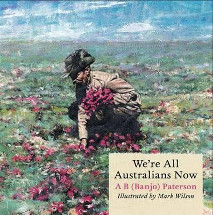We're all Australians now by A B (Banjo) Paterson

Ill. by Mark Wilson. Angus & Robertson, 2015. ISBN 9780732296476
(Age: 8+) Recommended. World War One. ANZAC. Poetry. In his poetic
style, Banjo Paterson sent an open letter to the troops as they
fought in the war in Europe. Angus & Robertson have published
this beautifully illustrated book, setting the poem against Mark
Wilson's pictures of the war they faced. Banjo was well known in
Australia and many people learnt his poems by rote and could recite
them at will. He was revered as a poet who captured the Australian
core.
Each stanza of the poem extolling the virtues of a united Australia,
is illustrated with aspects of the war they fought and complimented
with images of people back home. So we have an image of the men
fighting their way up the Turkish hills on Gallipoli's coast, with
an image of a poster imploring recently graduated nurses to join up,
and a woman watching down on them all, while a man sits on his horse
under the Australian sun. Each image represents an aspect of war and
home, encouraging younger readers to ponder the lives led by these
people. I was struck particularly with the image of men advancing
across an open piece of land, contrasting with the women doing their
work back home, pulling along the coal trucks. And the nod to Walter
Withers, an Australian painter at the time, is wonderful, contrasting
the quiet life back home with the men packed and going off to war.
Each page is filled with things to look at and ponder, to wonder and
respond.
With the vast numbers of books about World War One published at the
moment, it is a change to see something written at the time, a poem
which underlined the feeling that Gallipoli made Australia,
Australia, that it overcame the state loyalties and divisions and
made people think of the reason for Federation only fifteen years
before. The Anzac heroism gave Australians a reason to be proud.
References to poppies, Gallipoli, Simpson and his donkey, Alec
Campbell, nurses, women back home, HMAS Sydney and wattle, amongst
others, will attract eager readers to look at the images shown and
reason why they are included.
Fran Knight